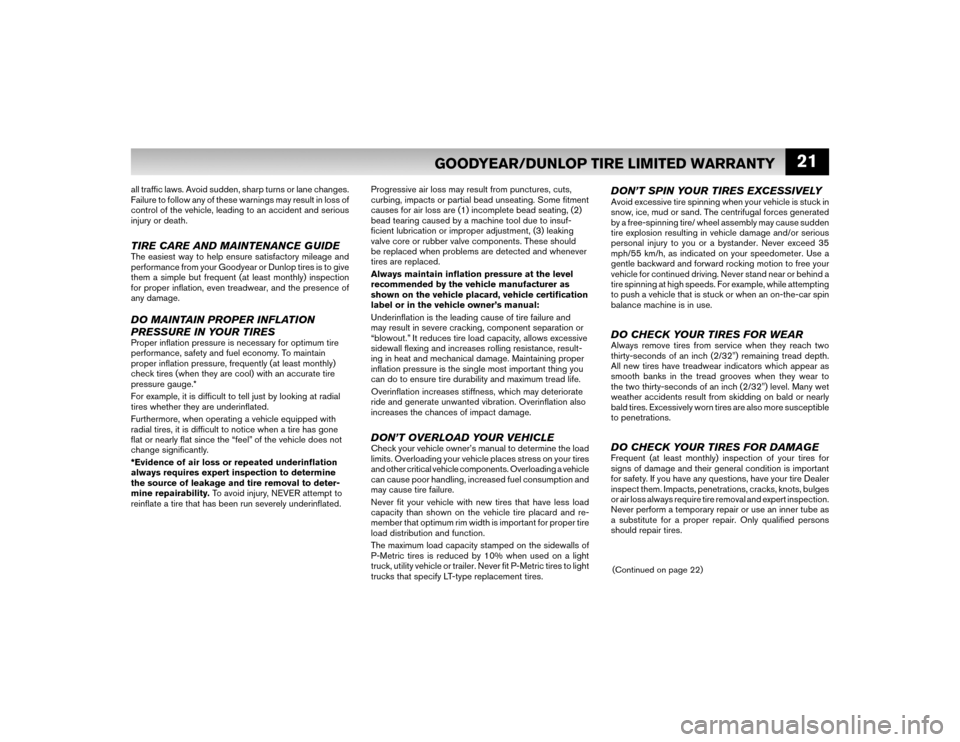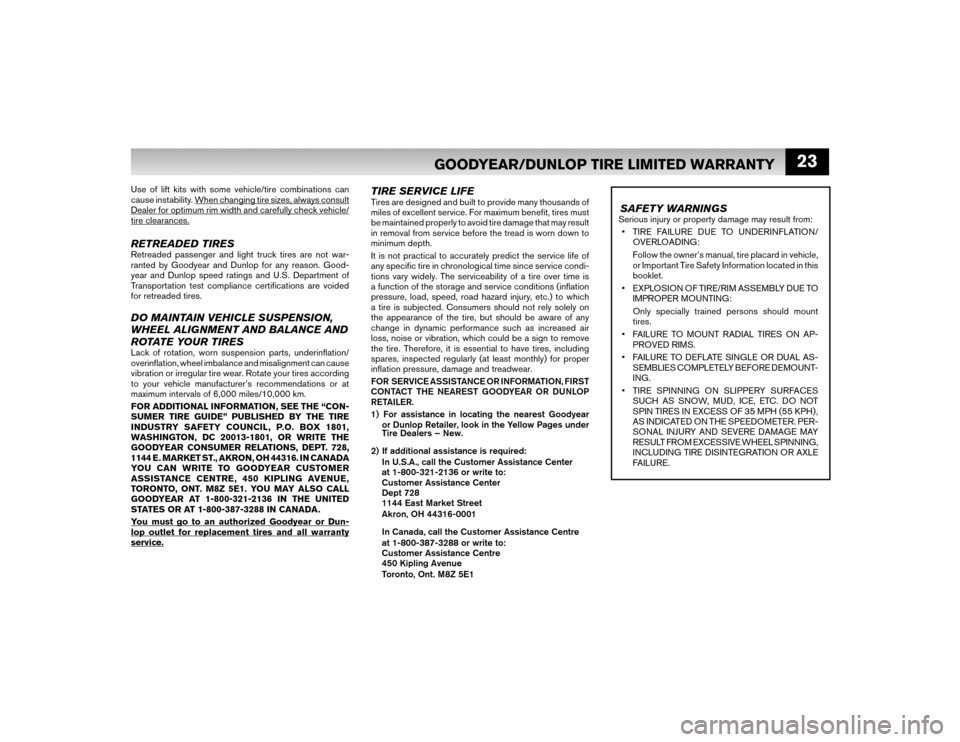2009 NISSAN VERSA HATCHBACK width
[x] Cancel search: widthPage 24 of 55

21
all traffi c laws. Avoid sudden, sharp turns or lane changes.
Failure to follow any of these warnings may result in loss of
control of the vehicle, leading to an accident and serious
injury or death.TIRE CARE AND MAINTENANCE GUIDEThe easiest way to help ensure satisfactory mileage and
performance from your Goodyear or Dunlop tires is to give
them a simple but frequent (at least monthly) inspection
for proper infl ation, even treadwear, and the presence of
any damage.DO MAINTAIN PROPER INFLATION
PRESSURE IN YOUR TIRESProper infl ation pressure is necessary for optimum tire
performance, safety and fuel economy. To maintain
proper infl ation pressure, frequently (at least monthly)
check tires (when they are cool) with an accurate tire
pressure gauge.*
For example, it is diffi cult to tell just by looking at radial
tires whether they are underinfl ated.
Furthermore, when operating a vehicle equipped with
radial tires, it is diffi cult to notice when a tire has gone
fl at or nearly fl at since the “feel” of the vehicle does not
change signifi cantly.
*Evidence of air loss or repeated underinfl ation
always requires expert inspection to determine
the source of leakage and tire removal to deter-
mine repairability. To avoid injury, NEVER attempt to
reinfl ate a tire that has been run severely underinfl ated.Progressive air loss may result from punctures, cuts,
curbing, impacts or partial bead unseating. Some fi tment
causes for air loss are (1) incomplete bead seating, (2)
bead tearing caused by a machine tool due to insuf-
fi cient lubrication or improper adjustment, (3) leaking
valve core or rubber valve components. These should
be replaced when problems are detected and whenever
tires are replaced.
Always maintain infl ation pressure at the level
recommended by the vehicle manufacturer as
shown on the vehicle placard, vehicle certifi cation
label or in the vehicle owner’s manual:
Underinfl ation is the leading cause of tire failure and
may result in severe cracking, component separation or
“blowout.” It reduces tire load capacity, allows excessive
sidewall fl exing and increases rolling resistance, result-
ing in heat and mechanical damage. Maintaining proper
infl ation pressure is the single most important thing you
can do to ensure tire durability and maximum tread life.
Overinfl ation increases stiffness, which may deteriorate
ride and generate unwanted vibration. Overinfl ation also
increases the chances of impact damage.
DON’T OVERLOAD YOUR VEHICLECheck your vehicle owner’s manual to determine the load
limits. Overloading your vehicle places stress on your tires
and other critical vehicle components. Overloading a vehicle
can cause poor handling, increased fuel consumption and
may cause tire failure.
Never fi t your vehicle with new tires that have less load
capacity than shown on the vehicle tire placard and re-
member that optimum rim width is important for proper tire
load distribution and function.
The maximum load capacity stamped on the sidewalls of
P-Metric tires is reduced by 10% when used on a light
truck, utility vehicle or trailer. Never fi t P-Metric tires to light
trucks that specify LT-type replacement tires.
DON’T SPIN YOUR TIRES EXCESSIVELYAvoid excessive tire spinning when your vehicle is stuck in
snow, ice, mud or sand. The centrifugal forces generated
by a free-spinning tire/ wheel assembly may cause sudden
tire explosion resulting in vehicle damage and/or serious
personal injury to you or a bystander. Never exceed 35
mph/55 km/h, as indicated on your speedometer. Use a
gentle backward and forward rocking motion to free your
vehicle for continued driving. Never stand near or behind a
tire spinning at high speeds. For example, while attempting
to push a vehicle that is stuck or when an on-the-car spin
balance machine is in use.DO CHECK YOUR TIRES FOR WEARAlways remove tires from service when they reach two
thirty-seconds of an inch (2/32") remaining tread depth.
All new tires have treadwear indicators which appear as
smooth banks in the tread grooves when they wear to
the two thirty-seconds of an inch (2/32") level. Many wet
weather accidents result from skidding on bald or nearly
bald tires. Excessively worn tires are also more susceptible
to penetrations.DO CHECK YOUR TIRES FOR DAMAGEFrequent (at least monthly) inspection of your tires for
signs of damage and their general condition is important
for safety. If you have any questions, have your tire Dealer
inspect them. Impacts, penetrations, cracks, knots, bulges
or air loss always require tire removal and expert inspection.
Never perform a temporary repair or use an inner tube as
a substitute for a proper repair. Only qualifi ed persons
should repair tires.
GOODYEAR/DUNLOP TIRE LIMITED WARRANTY
(Continued on page 22)
Page 26 of 55

23
GOODYEAR/DUNLOP TIRE LIMITED WARRANTY
Use of lift kits with some vehicle/tire combinations can
cause instability. When changing tire sizes, always consult
Dealer for optimum rim width and carefully check vehicle/
tire clearances.RETREADED TIRESRetreaded passenger and light truck tires are not war-
ranted by Goodyear and Dunlop for any reason. Good-
year and Dunlop speed ratings and U.S. Department of
Transportation test compliance certifi cations are voided
for retreaded tires.DO MAINTAIN VEHICLE SUSPENSION,
WHEEL ALIGNMENT AND BALANCE AND
ROTATE YOUR TIRESLack of rotation, worn suspension parts, underinfl ation/
overinfl ation, wheel imbalance and misalignment can cause
vibration or irregular tire wear. Rotate your tires according
to your vehicle manufacturer’s recommendations or at
maximum intervals of 6,000 miles/10,000 km.
FOR ADDITIONAL INFORMATION, SEE THE “CON-
SUMER TIRE GUIDE” PUBLISHED BY THE TIRE
INDUSTRY SAFETY COUNCIL, P.O. BOX 1801,
WASHINGTON, DC 20013-1801, OR WRITE THE
GOODYEAR CONSUMER RELATIONS, DEPT. 728,
1144 E. MARKET ST., AKRON, OH 44316. IN CANADA
YOU CAN WRITE TO GOODYEAR CUSTOMER
ASSISTANCE CENTRE, 450 KIPLING AVENUE,
TORONTO, ONT. M8Z 5E1. YOU MAY ALSO CALL
GOODYEAR AT 1-800-321-2136 IN THE UNITED
STATES OR AT 1-800-387-3288 IN CANADA.
You must go to an authorized Goodyear or Dun-
lop outlet for replacement tires and all warranty
service.
TIRE SERVICE LIFETires are designed and built to provide many thousands of
miles of excellent service. For maximum benefi t, tires must
be maintained properly to avoid tire damage that may result
in removal from service before the tread is worn down to
minimum depth.
It is not practical to accurately predict the service life of
any specifi c tire in chronological time since service condi-
tions vary widely. The serviceability of a tire over time is
a function of the storage and service conditions (infl ation
pressure, load, speed, road hazard injury, etc.) to which
a tire is subjected. Consumers should not rely solely on
the appearance of the tire, but should be aware of any
change in dynamic performance such as increased air
loss, noise or vibration, which could be a sign to remove
the tire. Therefore, it is essential to have tires, including
spares, inspected regularly (at least monthly) for proper
infl ation pressure, damage and treadwear.
FOR SERVICE ASSISTANCE OR INFORMATION, FIRST
CONTACT THE NEAREST GOODYEAR OR DUNLOP
RETAILER.
1) For assistance in locating the nearest Goodyear
or Dunlop Retailer, look in the Yellow Pages under
Tire Dealers – New.
2) If additional assistance is required:
In U.S.A., call the Customer Assistance Center
at 1-800-321-2136 or write to:
Customer Assistance Center
Dept 728
1144 East Market Street
Akron, OH 44316-0001
In Canada, call the Customer Assistance Centre
at 1-800-387-3288 or write to:
Customer Assistance Centre
450 Kipling Avenue
Toronto, Ont. M8Z 5E1
SAFETY WARNINGS Serious injury or property damage may result from:
• TIRE FAILURE DUE TO UNDERINFLATION/
OVERLOADING:
Follow the owner’s manual, tire placard in vehicle,
or Important Tire Safety Information located in this
booklet.
• EXPLOSION OF TIRE/RIM ASSEMBLY DUE TO
IMPROPER MOUNTING:
Only specially trained persons should mount
tires.
• FAILURE TO MOUNT RADIAL TIRES ON AP-
PROVED RIMS.
• FAILURE TO DEFLATE SINGLE OR DUAL AS-
SEMBLIES COMPLETELY BEFORE DEMOUNT-
ING.
• TIRE SPINNING ON SLIPPERY SURFACES
SUCH AS SNOW, MUD, ICE, ETC. DO NOT
SPIN TIRES IN EXCESS OF 35 MPH (55 KPH) ,
AS INDICATED ON THE SPEEDOMETER. PER-
SONAL INJURY AND SEVERE DAMAGE MAY
RESULT FROM EXCESSIVE WHEEL SPINNING,
INCLUDING TIRE DISINTEGRATION OR AXLE
FAILURE.